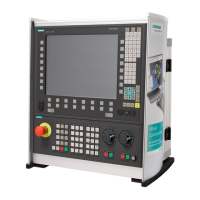
Do you have a question about the Siemens SINUMERIK 840D sl Turning and is the answer not in the manual?
| Control Unit Type | SINUMERIK 840D sl |
|---|---|
| Application | Turning |
| Number of axes | Up to 31 |
| Number of spindles | Up to 10 |
| NC channels | Up to 10 |
| PLC | Integrated SIMATIC S7-300 |
| Communication | PROFINET, PROFIBUS, Ethernet |
| Programming | DIN/ISO |
| Interface | Ethernet, USB |
| Data Storage | CF card, network storage |
| Operating Temperature | 0°C to 45°C |
Provides essential safety guidelines for machine operation and risk mitigation.
Details the non-binding nature of application examples and user responsibility.
Outlines measures for protecting systems, machines, and networks against cyber threats.
Introduces the SINUMERIK control system as a CNC for machine tools and its basic functions.
Describes the display and operation interface components of the SINUMERIK Operate user interface.
Details the available keys and key combinations for operating the control and machine tool.
Explains the optimization of the SINUMERIK Operate Generation 2 interface for touch and gesture operations.
Provides guidance on using touch panels, including glove compatibility and pressure.
Details various finger gestures like tap, pinch, and pan for interacting with the interface.
Describes the procedure for powering the control system on and off.
Explains how to reference machine axes, including collision risk and procedure.
Details the three different operating modes available (JOG, MDI, AUTO) and mode groups.
Covers essential machine settings like coordinate system and unit of measurement.
Explains how to enter and reset position values for axes and work offsets.
Details methods for determining tool offset data, including manual and probe measurements.
Describes how to determine the workpiece zero point by measuring its length and face surface.
Explains machine zero vs. workpiece zero and the role of base, coarse, and fine offsets.
Outlines the use of "JOG" mode for setup and simple traversing movements.
Covers tool selection and spindle control within the T,S,M window.
Details how to manually start, stop, and set spindle speed and direction.
Explains how to position the spindle at a specific angle for operations like tool changes.
Describes how to move axes manually using increments or axis keys.
Explains how to traverse axes to specific positions for simple machining.
Covers retracting drilling tools or handling interruptions during thread tapping.
Details the cycle for turning the face surface of the workpiece.
Explains how to synchronize the spindle to an existing thread turn for re-machining.
Specifies configurations for manual mode in the "Settings for manual operation" window.
Outlines the steps to start, stop, and cancel program execution during machining.
Describes how to select programs from the Program Manager for execution.
Explains how to test programs block-by-block for machining control.
Details how to view currently executed program blocks and machining times.
Explains how to view precise axis positions and important G functions during testing.
Describes how to display the current program level during execution of large programs with subprograms.
Provides options for correcting programs when syntax errors are detected.
Explains how to move tools away from the contour after a program interruption and resume execution.
Covers methods for starting program execution from a specific block or search target.
Details various modes for controlling program execution like PRT, DRY, RG0, M01, M101, DRF, SB.
Explains how to skip program blocks that are not to be executed every time.
Describes how to execute technological parameters before program start for a single run.
Covers various functions for editing part programs, including search and replace.
Explains how to use the search function to find specific points in programs.
Details how to find and replace text within programs in a single step.
Covers operations for inserting, cutting, copying, and pasting program blocks.
Explains how to modify block numbering in programs opened in the editor.
Describes how to combine several blocks to form program blocks for better structure.
Covers viewing and editing multiple programs simultaneously in the editor.
Details default settings for the editor that take effect automatically when opened.
Explains how to open, clean, enlarge, reduce, and rotate DXF files.
Covers the general procedure for importing and editing DXF files.
Details how to specify a reference point for DXF files, as their zero point often differs.
Explains how to select the machining plane for contours created with the DXF reader.
Covers entering a snap radius to compensate for gaps in drawings.
Describes how to select and delete ranges and elements within DXF files.
Explains how to save reduced and edited DXF files.
Details how to transfer drilling positions from DXF files to cycles.
Covers the process of accepting contours created from DXF files.
Explains how to display and edit user variables like R parameters and GUDs.
Describes global R parameters as arithmetic parameters that can be read/written by all channels.
Details R parameters as channel-specific variables for G code programs.
Explains how global user data (GUDs) remains available after the machine is switched off.
Describes channel-specific user variables that are applicable in all programs for each channel.
Explains that LUDs are only valid in the program where they were defined.
Details PUDs as global part program variables valid in all main programs and subprograms.
Covers searching for R parameters and user variables within lists.
Explains how to display selected G groups and available G functions.
Details the 16 selected G groups and currently active G functions.
Lists G groups displayed by default.
Lists G groups displayed by default according to ISO code.
Lists all G groups and their group numbers in the "G Functions" window.
Highlights important information for machining free-form surfaces using High Speed Settings.
Lists programmed values for specific information in the "All G functions" window.
Explains M and H functions preprogrammed by the manufacturer.
Describes the display of current M and H functions in the "Auxiliary Functions" window.
Covers displaying handwheel axis offsets or programmed superimposed movements.
Explains how to display machining paths for large mold making programs for a fast overview.
Lists NC blocks supported for mold making view, including types, orientation, and G codes.
Details options for adjusting the view for better assessment of the workpiece.
Step-by-step guide to opening the mold making view.
Explains how to adapt the graphic for better assessment.
Describes how to jump directly to a program block from the graphic for editing.
Explains how to search for program blocks where edits can be made.
Covers enlarging, reducing, moving, and rotating the graphical representation.
Details how to adjust the size of the graphical representation.
Explains how to reposition and rotate the graphic using cursor keys or mouse.
Explains how to shift and change the size of the mold building view section.
Covers gaining an overview of program runtime and workpiece count.
Explains how to test programs to identify errors at an early stage.
Describes simulation as a way to verify programming results without machine axis movement.
Explains how simulation uses workpiece proportions and tool data for screen display.
Details how depth infeed is color-coded to indicate machining depth.
Explains that blank dimensions from the program editor are used for the workpiece.
Covers context regarding machine references.
Allows choosing between material removal simulation and path display.
Covers three graphical display variants: simulation before machining, simultaneous recording before, and during machining.
Lists available views like Side, Half cut, Front, 3D, and 2-window.
Shows current axis coordinates, override, tool, feedrate, and machining time.
Explains that program runtime is determined during simulation.
Details traversing paths and optimum display properties.
Explains how start position is converted via zero offset and how simultaneous recording begins.
Describes performing a quick run-through to graphically display program execution before actual machining.
Explains how to graphically display program execution for monitoring during program test.
Covers tracking program execution on screen while machining is active.
Details various graphical views for workpiece machining display.
Explains how to display and change the side view of the workpiece.
Describes displaying the workpiece in a half-cut view.
Explains how to display the workpiece in the X-Y plane.
Covers displaying the workpiece as a three-dimensional model.
Details the 2-window view containing side and front views of the workpiece.
Explains the graphical display of traversing paths and active window.
Covers blank display and showing/hiding the tool path.
Explains how to replace or define a blank for programs where it cannot be inserted.
Details how to show or hide the programmed tool path.
Explains how to change feedrate and select maximum feedrate during simulation.
Details how to adjust feedrate during simulation.
Covers controlling program execution block by block during simulation.
Explains how to enlarge, reduce, pan, rotate, and modify the simulation graphic.
Details how to adjust the size of the graphical representation.
Explains how to move the graphic up, down, left, or right.
Describes how to rotate the workpiece view in 3D.
Explains how to shift and change the size of the mold building view section.
Covers displaying certain views to show hidden contours in 3D view.
Explains how alarms during simulation runs are displayed and managed.
Lists available functionalities for G code programming, including cycles and contour input.
Details conditions for calling and returning from cycles and programmable frames.
Covers displaying G code programs in various views like program view and parameter screen.
Describes the overview of individual machining steps provided by the program view in the editor.
Explains how machining times are displayed based on automatic mode settings.
Details color highlighting for G code commands and keywords in the editor settings.
Outlines the three sub-areas of a G code program: header, blocks, and end of program.
Explains basic concepts like machining planes and current planes in cycles.
Defines machining planes by coordinate axes and their relevance for tool offset calculation.
Describes plane selection boxes in input screens when not specified by NC data.
Details how to call tools, select them from the tool list, and program parameters like tool change and spindle settings.
Guides on creating separate programs for each workpiece with individual machining steps.
Steps for creating a new part program in the Program Manager.
Steps for creating a new G code program for a workpiece.
Explains the use of blanks for simulation and simultaneous recording, defining shape and dimensions.
Details general parameters that repeat in program headers and cycle input screens.
Provides an overview of available machining steps and their selection.
Details how to call technology cycles and manage their parameters.
Describes how certain parameters can be hidden in screens depending on manufacturer settings.
Discusses the upward compatibility of cycle support across software versions.
Explains the use of variables and expressions in screen forms.
Covers how to change parameters of a cycle call.
Introduces graphic programming for generating machining step programs directly at the machine.
Lists functionalities like technology-oriented step selection, input windows, online help, and contour input.
Covers displaying ShopTurn programs in Work plan, Graphic view, or Parameter screen.
Explains the overview of individual machining steps in the work plan.
Details how machining times are recorded and displayed.
Explains color highlighting for G code commands in the program editor.
Outlines the three sub-areas of a machining step program: header, blocks, and end of program.
Covers parameters affecting the entire program, like blank dimensions and retraction planes.
Details determining individual machining steps and specifying technology data and positions.
Explains how technology and positioning blocks are linked and connected.
Signals the end of workpiece machining and sets program repetition.
Explains basic concepts like machining planes and their types.
Defines machining planes by coordinate axes and their relevance for tool offset calculation.
Explains the standard approach and retraction pattern in machining cycles.
Covers inputting positions in absolute or incremental dimensions based on workpiece drawings.
Details specifying positions using right-angled or polar coordinates.
Mentions that the "Clamp spindle" function is set up by the machine manufacturer.
Lists parameters effective for the complete program, like blank dimensions and retraction planes.
Guides on defining individual machining steps in program blocks after creating the header.
Explains how to select technological functions and their parameters.
Details the process of selecting tools and loading them into the editor.
Lists parameters to be entered for every program block.
Covers programming tools by name or location number, including modal selection.
Explains the need for selecting or specifying the cutting edge number for tools with multiple edges.
Details the option of programming machining with or without radius compensation.
Defines feedrate as speed at which axes move during machining.
Explains spindle speed programming in RPM.
Covers cutting rate as circumferential velocity in m/min.
Details options for roughing, finishing, complete machining, edge finishing, and base finishing.
Explains how to call work offsets (G54, etc.) from any program and view coordinates.
Covers programming steps to be executed more than once using start and end markers.
Details how to specify the quantity of workpieces to be produced.
Explains how to optimize parameters or adapt blocks to new situations.
Covers changing parameters in the program header and basic settings for machining direction.
Provides an overview of available machining steps and their selection.
Details how to call technology cycles and manage their parameters.
Explains the parameter check during program creation.
Explains the use of variables and expressions in screen forms.
Covers how to change parameters of a cycle call.
Details programming special cycles for approach/retraction.
Covers general geometry parameters and drilling positions for various drilling cycles.
Explains general geometry parameters like retraction plane and safety clearance.
Details the centering function for drilling holes.
Covers the drilling cycle for various depths and input methods.
Explains the reaming cycle and its parameters.
Details the deep-hole drilling cycle with multiple infeed steps and chip breaking.
Covers the deep-hole drilling cycle which includes predrilling and pilot hole functions.
Explains the tapping cycle for internal threads with constant or variable pitch.
Details using a drill and thread milling cutter for internal threads.
Explains programming arbitrary positions and patterns like line, grid, frame, circle, and pitch circle.
Covers programming any positions in rectangular or polar coordinates.
Explains programming positions at equal distances along a line.
Details programming holes on a full or pitch circle with defined radius.
Covers milling simple or complex contours with open or closed elements.
Introduces the contour milling cycle and its capabilities.
Explains how contours are represented in G code and ShopTurn programs.
Details symbols used to represent contour elements and their status.
Explains the progress of contour programming shown in broken-line graphics.
Guides on creating new contours by specifying starting points and elements.
Explains how the input creates a reference to the selected contour.
Covers milling along any programmed contour with cutter radius compensation.
Details the stock removal function for machining contours.
Explains the function for removing residual material after grooving.
Covers removing residual material from pockets.
Explains removing residual material from spigots.
Details milling pockets on face or peripheral surfaces.
Explains milling spigots on face or peripheral surfaces.
Covers the open slot function for machining open slots.
Details milling longitudinal grooves.
Explains milling circumferential slots.
Allows simultaneous viewing of several channels in Machine and Program operating areas.
Explains SINUMERIK Operate support for multi-channel machines.
Covers generating, simulating, and running-in programs on multi-channel machines.
Details combining programs for multi-channel machining into one workpiece.
Explains how to enter data applicable to all channels for G code and ShopTurn programs.
Covers changing job list composition and channel assignments.
Details editing G code multi-channel programs.
Explains how to add multi-channel cycles (CYCLE208) subsequently.
Describes how to modify blank parameters.
Covers changing job list composition and channel assignments.
Details setting parameters effective for the complete program in multi-channel data.
Explains synchronizing counter-spindle steps across all channels.
Covers simultaneous machining with 2 channels (4 axes).
Explains obtaining an overview of program sequences and coordinating channels.
Lists commands for synchronizing programs like START, WAITM, WAITMC, WAITE, SETM, CLEARM, GET, RELEASE.
Covers shifting program blocks to longer wait points to reduce machining time.
Explains splitting existing programs into desired blocks automatically.
Details creating automated program blocks.
Covers opening, closing, and creating additional blocks in converted programs.
Explains how to simulate machining for classic lathes with main and counterspindles.
Mentions required software options for collision avoidance functions.
Details the preconditions and procedure for activating collision avoidance.
Explains how to separately activate or deactivate collision monitoring for machine and tools.
Covers displaying tools, magazine locations, sorting, and filtering lists.
Details all parameters and functions for creating and setting up tools.
Explains column headings like Location, BS, Type, Tool name, ST, D, and Radius.
Provides an overview of available tool types for new tool creation.
Gives an overview of the dimensioning of tools with diagrams.
Guides on creating new tools from favorites or special tool types.
Explains how to create a new tool from a file.
Covers unloading tools from a magazine and writing data to a file.
Explains how to delete tools from a file.
Details parameters and functions for monitoring tool wear during operation.
Explains how to replace disabled tools or make them ready for use again.
Covers relocating tools within magazines to different locations.
Explains options for managing multiple tools in magazines.
Covers displaying tool data, cutting edge data, and monitoring data.
Explains how to display parameters of selected tools.
Details data provided in the "Tool Details" window.
Explains data provided on the selected tool when the "Cutting edge data" softkey is active.
Details data provided on the selected tool when the "Monitoring data" softkey is active.
Explains how to display tools sorted by different criteria.
Covers filtering tools based on specific properties.
Details the search function in tool management lists.
Explains how to change cutting edge position or tool type.
Covers storing more than one tool at a magazine location using multitools.
Explains the supplemented tool list when working with multitools.
Guides on creating multitools from favorites or special tool types.
Details how to equip multitools with tools.
Explains how to remove tools from a multitool.
Covers deleting multitools and their associated tools.
Details loading and unloading multitools to/from magazines.
Explains how to reactivate disabled multitools and tools.
Covers relocating multitools between magazine locations.
Explains how to position a multitool in the spindle.
Introduces accessing programs for execution, editing, copying, or renaming.
Describes the display of the complete NC working memory with tools, main programs, and subroutines.
Explains displaying workpieces, main programs, and subprograms saved on CF card or local hard disk.
Guides on managing program and data transparently by creating subdirectories.
Covers exchanging data via USB drives, including execution and partitioning.
Details options for transferring data between control system and external FTP server.
Explains how to view and modify programs in the editor.
Guides on selecting and executing programs, including automatic switching to Machine operating area.
Covers creating directories, programs, job lists, and program lists with naming rules.
Outlines rules for assigning names to files and directories.
Explains how to create subdirectories for managing programs and data.
Guides on creating various file types like main programs, initialization files, and tool offsets within a workpiece.
Details how to create G code programs and render G code blocks.
Explains creating ShopTurn programs and generating machining steps.
Covers creating files in any format within directories or subdirectories.
Explains creating job lists for extended workpiece selection, specifying program selection in different channels.
Details checking and executing job lists.
Covers searching for directories and files in the Program Manager.
Explains how to show program content in a preview before editing.
Details selecting multiple files and directories for processing.
Covers copying and pasting directories/programs for creating new ones or exchanging data.
Explains how to delete unused programs or directories.
Covers displaying and changing file/directory properties like access rights.
Details configuring logical drives (data carriers) for access.
Lists configurable logical drives like USB, Network, CompactFlash, and Local Hard Disk.
Explains configuring softkeys in the Program Manager via the "Set Up Drives" window.
Details USB interface specifications.
Provides specifications for local drives.
Details specifications for network drives.
Covers requirements for using external storage for program execution.
Explains how to display HTML and PDF documents via the Program Manager.
Details the EXTCALL command for accessing files from drives and subprograms.
Explains executing part programs from external storage.
Covers generating archives in Program Manager and system data.
Guides on archiving individual files from NC memory or local drive.
Explains backing up specific data files directly from the data tree.
Details how to read archives from system data or configured drives.
Covers reading archives directly from the data tree.
Explains backing up and reading setup data like tool data, zero points, and magazine assignments.
Guides on backing up tool data, zero points, and magazine assignments.
Details selecting backed-up data to read in, such as tool data, magazine assignments, and zero points.
Covers saving R-parameters and global user variables for specific programs.
Details reading-in and reading-out archives via serial interface and V24 settings.
Explains V24 serial interface usage for archive transfer.
Covers V24 interface settings like protocol, transfer, baud rate, and archive format.
Explains how alarms are generated during machining and how to resolve them.
Details information displayed in the alarm overview: date, time, criterion, number, and text.
Covers listing all occurred alarms and messages in chronological order.
Explains how PLC and part program messages are issued during machining.
Details sorting alarms, messages, and logs by date or number.
Covers creating and saving screenshots of the user interface.
Explains displaying and editing PLC and NC variables with password protection.
Guides on entering, monitoring, and changing NC/PLC variables.
Details saving and loading configurations of variables in screen forms.
Explains how to display version data for system software, PLC, expansions, OEM applications, and hardware.
Covers displaying version information for various machine components.
Explains how to save machine-specific information as a configuration file.
Provides machine history in electronic form for service and optimization.
Covers editing machine identity, making logbook entries, and deleting entries.
Guides on making new entries in the logbook using the "New logbook entry" window.
Explains how to search for specific entries in the logbook.
Covers setting remote access rights and requesting remote diagnostics.
Details influencing remote access by setting rights for operating modes.
Explains how to permit remote access via teleservice adapter.
Covers actively requesting remote diagnostics with the machinery construction OEM.
Explains how to block modem access or reset access rights.
Introduces "Manual Machine" for carrying out machining processes without writing a program.
Lists available options for machining workpieces: Manual mode and Single-cycle machining.
Explains inputting parameters directly for simple traversing movements.
Details selecting the desired tool, feedrate, and spindle direction.
Covers selecting effective direction and entering taper angle.
Explains performing straight and circular machining using functions.
Details simple, straight machining like face or longitudinal turning.
Covers simple circular machining.
Lists functions available for comprehensive machining in manual mode.
Explains how to drill a position pattern.
Details drilling functions available in manual mode.
Covers turning functions available in manual mode.
Explains milling functions available in manual mode.
Covers checking machining results via simulation without axis movement.
Explains the use of pre-defined blank shapes for graphical display.
Guides on directly selecting work offsets in the "Parameter" operating area.
Explains limiting axis traversing range by entering values for axes.
Covers aligning milling machines and lathes with an additional B axis.
Details alignment angles required for turning with tool alignment.
Explains turning operations and how B axis is used.
Covers displaying the B axis in various windows.
Explains input fields for β and γ angles for tool alignment.
Covers face and peripheral surface machining with a B axis.
Explains face machining using B axis position.
Details peripheral surface machining using B axis position.
Explains defining inclined surfaces in a swivel mask.
Covers swiveling coordinate systems using various methods like axis-by-axis, solid angle, projection angle, and directly.
Explains optimizing approach/return for swiveling with B axis using special cycles.
Details programming patterns for machining on inclined surfaces.
Explains programming in the basic coordinate system, irrespective of tool holder.
Covers mirroring of X and Y axes and offset for the second tool holder.
Lists points to consider for G code programming with two tool holders.
Details how to set tool holder for measuring a tool.
Introduces the "Teach in" function for editing programs in "AUTO" and "MDA" modes.
Outlines steps for creating and modifying traversing blocks.
Guides on inserting empty lines and program blocks.
Explains overwriting program blocks with teach-in blocks of the same type.
Covers setting the interrupt pointer to the cursor position for resuming program execution.
Explains how to delete teach-in blocks and program blocks.
Details teach-in for position, rapid traverse, straight line, circular interpolation, and A-spline.
Lists parameters for axes and feedrate for teach-in.
Covers defining axes and parameters for teach-in blocks.
Introduces the HT 8 handheld terminal combining operator and machine control panel functions.
Describes the TFT color display, membrane keys, and external keyboard connection.
Explains arbitrary assignment and customer-specific configuration of customer keys.
Details the integrated MCP with keys and softkeys.
Covers the two acknowledgment buttons for operator actions.
Explains traversing axes using HT 8 keys in JOG or MDI mode.
Details the virtual keyboard as an input device for touch operator panels.
Explains special keys like Tilde, Eng, Num.
Covers returning to the full keyboard from the number block.
Explains the necessity of calibrating the touch panel upon first connection.
Lists options to improve machine energy utilization.
Covers acquiring and displaying energy consumption using SENTRON PAC.
Details defining and saving energy saving profiles.
Provides an overview of machine energy consumption.
Explains the Ctrl-Energy entry screen and its components.
Shows current power status of the machine in the status display.
Covers obtaining a detailed overview of energy usage for various components.
Explains measuring and recording energy consumption by part programs.
Details displaying actual and saved measurement curves graphically.
Covers displaying actual and saved usage values in a detailed table.
Explains comparing usage values of actual and saved measurements.
Details performing and saving long-term energy consumption measurements.
Covers displaying and activating/inhibiting energy-saving profiles.
Introduces Easy Extend for retrofitting machines with additional devices.
Explains communication between operator component and PLC via PLC user program.
Guides on enabling device options, which may be password-protected.
Details how to activate and deactivate functions for unlocked devices.
Covers commissioning devices, typically done by the machine manufacturer.
Provides an overview of the documentation for SINUMERIK 840D sl / 828D.
Lists various documentation categories like advertising brochures and system manuals.
Lists user manuals such as operating, programming, and diagnostics manuals.
Lists manufacturer/service documents like equipment manuals and commissioning manuals.
Lists resources for training and information.
Lists electronic documentation like DOCONCD and Industry Online Support.
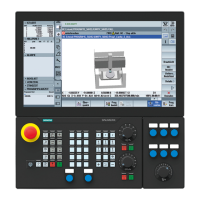
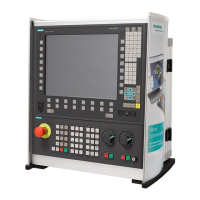

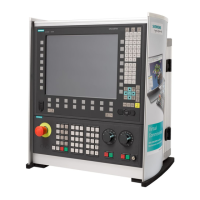
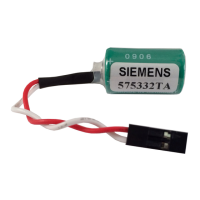
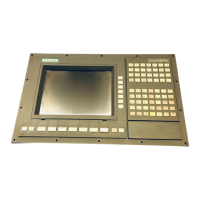

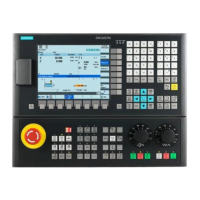
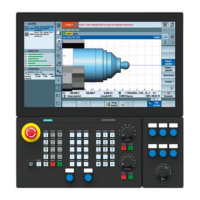
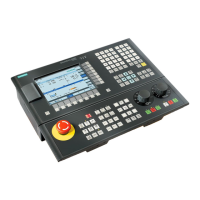
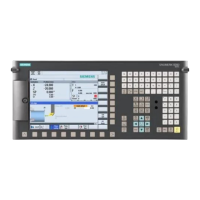
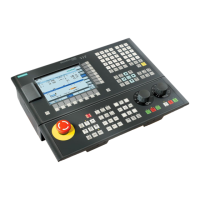
